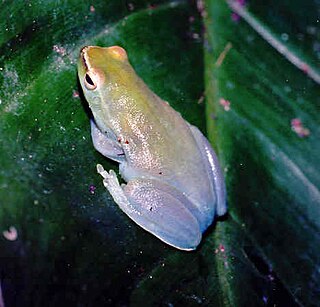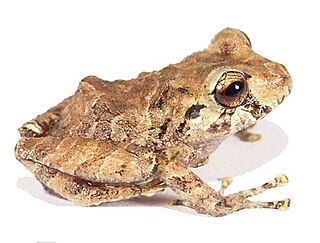
Sachatamia ilex is a species of frog in the family Centrolenidae. It is found in eastern Nicaragua, Costa Rica, Panama, western Colombia, and western Ecuador. Common name Limon giant glass frog has been coined for this species, apparently in reference to its type locality in the canton of Limón, Costa Rica, and it is also known as the ghost glass frog.

Callimedusa atelopoides is a species of frog in the subfamily Phyllomedusinae. It is known from Amazonian Bolivia, Brazil, and Peru, and is likely to be found in adjacent Colombia and Ecuador. Common name toady leaf frog has been proposed for it.
Callimedusa duellmani is a species of frog in the subfamily Phyllomedusinae. It is endemic to Peru and is only known from its type locality near Balzapata, upper Chiriaco River, in the Department of Amazonas. The specific name duellmani honors William E. Duellman, an American herpetologist. Common name purple and orange leaf frog has been proposed for it.

Sphaenorhynchus lacteus, the Orinoco lime treefrog or greater hatchet-faced treefrog, is a species of frog in the family Hylidae. It is a widely distributed species found in the Orinoco and Amazon basins in Venezuela, the Guianas, Colombia, Brazil, Ecuador, Peru, and Bolivia. It also occurs in Trinidad and Tobago.
Pristimantis croceoinguinis is a species of frog in the family Strabomantidae. It is found in the lowland Amazon rainforest of southern Colombia, eastern Ecuador, and extreme north-eastern Peru, likely also extending into the adjacent Brazil. The specific name croceoinguinis refers to the color of the inguinal spots of this frog. Common name Santa Cecilia robber frog has been proposed for it.
Pristimantis cryophilius is a species of frog in the family Strabomantidae. It is endemic to the Ecuadorian Andes in the Azuay, Cañar, and Morona-Santiago Provinces. The specific name cryophilius is derived from Greek kryos for cold and philois for loving and refers to the affinity of this species for cold climate. Common name San Vicente robber frog has been coined for it.
Niceforonia dolops is a species of frog in the family Strabomantidae. It is found in the Andes of southern Colombia and northern Ecuador. Specifically, it is known from the Cordillera Oriental and Colombian Massif in Caquetá and Putumayo Departments, Colombia, and Napo Province, Ecuador. Common name Putumayo robber frog has been coined for it.
Pristimantis eremitus is a species of frog in the family Strabomantidae. It is found in the Cordillera Occidental in north-western Ecuador from the Cotopaxi Province northward and on western slope of the Colombian Massif in the Nariño Department, extreme south-western Colombia. The specific name eremitus is Latin for "lonely" or "solitary" and refers to this species being the only western-Andean species among its closest relatives. Common names Chiriboga robber frog and lonely rainfrog have been coined for it.
Pristimantis gentryi is a species of frogs in the family Strabomantidae. It is endemic to central Ecuador where it is found in a small area west of the Páramo de Apagua, Cotopaxi Province. The specific name gentryi honors Alwyn Gentry, American botanist who perished during his field work in Ecuador. Common name Pilalo robber frog has been proposed for this species.

Pristimantis katoptroides is a species of frog in the family Strabomantidae. It is found in the eastern slopes of the Andes of Ecuador and Cordillera Central and eastern Andean foothills in northwestern Peru. The specific name katoptroides is Greek for "mirror-like" and refers to the similarity of this species to Pristimantis crucifer, but being found on the other side of the Andes. Common name Puyo robber frog has been proposed for it.
Pristimantis serendipitus is a species of frog in the family Strabomantidae. It is found in the Andes of northern Peru and adjacent southern Ecuador. The specific name refers to serendipitous discovery of this species: collection at the type locality was only made because the road was closed by an accident. Common name Colan Mountains robber frog has been proposed for this species.
Pristimantis simonbolivari is a species of frog in the family Strabomantidae. It is endemic to Ecuador and known only from the region of its type locality, Cashca Totoras, Cordillera Occidental, in the Bolívar Province. The specific name simonbolivari honors Simón Bolívar. Common name Simon's ground frog has been proposed for it.
Pristimantis variabilis is a species of frog in the family Strabomantidae. It is found in the lowland Amazon rainforest and Andean slopes in southern Colombia, eastern Ecuador, eastern Peru, and western Brazil. The specific name variabilis refers to the variable dorsal coloration of this frog. Common name variable robber frog has been proposed for it.

Engystomops coloradorum, also known as Colorado dwarf frog, is a species of frogs in the family Leptodactylidae. It is endemic to the Pacific lowlands and foothills of the Andes in the Pichincha and Santo Domingo de los Tsáchilas Provinces, Ecuador.
Chiasmocleis antenori, also known as the Ecuador silent frog, is a species of frog in the family Microhylidae. It is found in eastern Ecuador, eastern Peru, and western Brazil (Acre). It might be a species complex.
Boana nympha is a species of frog in the family Hylidae. It is endemic to the upper Amazon basin of southern Colombia, eastern Ecuador, and northeastern Peru; its range probably extends into adjacent western Brazil. The specific name nympha alludes to nymphs, beautiful wood- and marsh-dwelling goddesses in Greek mythology. Common name nympha Amazon treefrog has been proposed for it.

Pristimantis acerus is a species of frog in the family Strabomantidae. It is endemic to Ecuador and known from the area of its type locality between Papallacta and Cuyujúathe in the Napo Province and from the Llanganates National Park, Pastaza Province. This species is rated as Endangered by the IUCN. Common name Papallacta robber frog has been coined for it.

Pristimantis mallii is a species of frog in the family Strabomantidae. It is endemic to Ecuador. Described in 2019, it is only known from the Río Zuñag Reserve on the eastern slope of the Andes, in the upper basin of the Pastaza River. The specific name mallii honors V. N. Mallikarjuna "Malli" Rao, winner of Lavoisier Medal who helped develop an environmentally safe alternative to the fluorocarbons and whose donation helped establish the Río Zuñag Reserve. Common name Malli's rain frog has been coined for this species.
Hyloscirtus mashpi, also known as Mashpi torrenteer and Mashpi stream treefrog, is a species of frogs in the family Hylidae. It is endemic to the western slopes of the Ecuadorian Andes and known from a few localities in Pichincha, Imbabura, and Esmeraldas Provinces. It is named after its type locality, Mashpi Reserve. Furthermore, the word mashpi is a Yumbo word meaning "friend of water", which agrees with the habitat requirements of this species.
Lynchius megacephalus, also known as the big-headed Andes frog, is a species of frog in the family Strabomantidae. It is endemic to Ecuador and only known from its type locality, Ecological Conservation Area Tinajillas-Río Gualaceño in the Morona-Santiago Province. The specific name megacephalus refers to the relatively large head of this frog.







